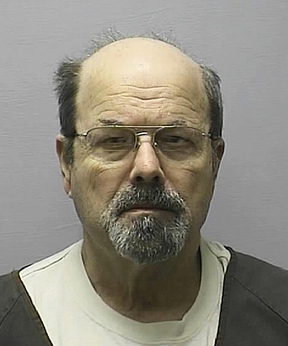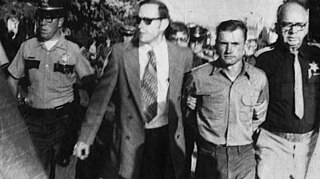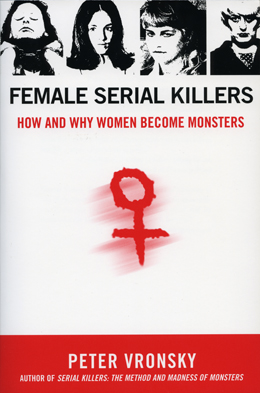
A serial killer is typically a person who murders three or more persons, with the murders taking place over more than a month and including a significant period of time between them. While most authorities set a threshold of three murders, others extend it to four or lessen it to two.

Dennis Lynn Rader is an American serial killer known as BTK, the BTK Strangler or the BTK Killer. Between 1974 and 1991, he killed ten people in Wichita and Park City, Kansas, and sent taunting letters to police and media outlets describing the details of his crimes. After a decade-long hiatus, Rader resumed sending letters in 2004, leading to his 2005 arrest and subsequent guilty plea. He is currently serving 10 consecutive life sentences at the El Dorado Correctional Facility.
The National Center for the Analysis of Violent Crime (NCAVC) is a specialist FBI department. The NCAVC's role is to coordinate investigative and operational support functions, criminological research, and training in order to provide assistance to federal, state, local, and foreign law enforcement agencies investigating unusual or repetitive violent crimes.
The Behavioral Analysis Unit (BAU) is a department of the Federal Bureau of Investigation's National Center for the Analysis of Violent Crime (NCAVC) that uses behavioral analysts to assist in criminal investigations. The mission of the NCAVC and the BAU is to provide behavioral based investigative and/or operational support by applying case experience, research, and training to complex and time-sensitive crimes, typically involving acts or threats of violence.

Robert Kenneth Ressler was an FBI agent and author. He played a significant role in the psychological profiling of violent offenders in the 1970s and is often credited with coining the term "serial killer", though the term is a direct translation of the German term "Serienmörder" coined in 1930 by Berlin investigator Ernst Gennat. After retiring from the FBI, he authored a number of books on serial murders, and often gave lectures on criminology.

In criminology, a disorganized offender is a type of serial killer classified by unorganized and spontaneous acts of violence. The distinction between "organized" and "disorganized" offenders was drawn by the American criminologist Roy Hazelwood. These profiles were also studied and modified in the FBI's Behavioral Science Unit located in Quantico, Virginia. By classifying these offenders into different categories, the FBI is able to track down offenders by studying their behavior and habits. One well-known example of a disorganized offender is Jack the Ripper.
The Violent Criminal Apprehension Program (ViCAP) is a unit of the United States Federal Bureau of Investigation responsible for the analysis of serial violent and sexual crimes, based in the Critical Incident Response Group's (CIRG) National Center for the Analysis of Violent Crime (NCAVC).

Offender profiling, also known as criminal profiling, is an investigative strategy used by law enforcement agencies to identify likely suspects and has been used by investigators to link cases that may have been committed by the same perpetrator. Multiple crimes may be linked to a specific offender and the profile may be used to predict the identified offender's future actions.
John Edward Douglas is an American retired special agent and unit chief in the United States Federal Bureau of Investigation (FBI). He was one of the first criminal profilers and has written and co-written books on criminal psychology, true crime novels, and his biography.

Scott Wilson Williams is a convicted American serial killer who lived in Monroe, North Carolina. He has been convicted for the murders of three women that took place over a period of nine years. He has also been convicted of crimes against two additional women who were not killed.
Serial crimes are crimes of a repetitive nature. Serial murder, serial rape and serial arson are crimes regarded as serial crimes. However, according to criminologists, a habitual offender or a career criminal is not necessarily a serial criminal.
The FBI method of profiling is a system created by the Federal Bureau of Investigation (FBI) used to detect and classify the major personality and behavioral characteristics of an individual based upon analysis of the crime or crimes the person committed. One of the first American profilers was FBI agent John E. Douglas, who was also instrumental in developing the behavioral science method of law enforcement.

Peter Vronsky is a Canadian author, filmmaker, and investigative historian. He holds a PhD in criminal justice history and espionage in international relations from the University of Toronto. He is the author of the bestseller true crime histories Serial Killers: The Method and Madness of Monsters (2004), Female Serial Killers: How and Why Women Become Monsters and Sons of Cain: A History of Serial Killers From the Stone Age to the Present (2018), a New York Times Editors' Choice, and most recently American Serial Killers: The Epidemic Years 1950–2000 (2021), a history exploring the epidemic surge of serial killers in the second half of the 20th century. He is the director of several feature films, including Bad Company (1980) and Mondo Moscow (1992). Vronsky is the creator of a body of formal video and electronic artworks and new media. He has also worked professionally in the motion picture and television industry as a producer and cinematographer in the field of documentary production and news broadcasting with CNN, CTV, CBC, RAI and other global television networks in North America and overseas. Vronsky's 2011 book, Ridgeway: The American Fenian Invasion and the 1866 Battle That Made Canada, is the definitive history of Canada's first modern battle – the Battle of Ridgeway fought against Irish American Fenian insurgents who invaded across the border from the United States on the eve of Canadian Confederation shortly after the American Civil War. He currently lectures at Toronto Metropolitan University's History Department in the history of international relations, terrorism, espionage, American Civil War, and the Third Reich. He consults as an investigative criminal historian to a number of law enforcement cold case homicide units including the NYPD, New York State Police, and Bergen County Prosecutor's Office New Jersey.

David Gail Meirhofer was an American serial killer who confessed to four murders in rural Montana between 1967 and 1974 — three of them children. Meirhofer killed himself shortly after confessing, and was never tried in court.

The Behavioral Science Unit (BSU) is the original name of a unit within the Federal Bureau of Investigation's (FBI) Training Division at Quantico, Virginia, formed in response to the rise of sexual assault and homicide in the 1970s. The unit was usurped by the Critical Incident Response Group (CIRG) and renamed the Behavioral Research and Instruction Unit (BRIU) and currently is called the Behavioral Analysis Unit (5) (BAU-5) within the National Center for Analysis of Violent Crime (NCAVC). The BAU-5 currently works on developing research and then using the evidence-based results to provide training and improve consultation in the behavioral sciences—understanding who criminals are, how they think, why they do what they do—for the FBI and law enforcement communities.
David J. Icove is a former Federal Bureau of Investigation Criminal Profiler and FBI Academy Instructor in the elite Behavioral Analysis Unit. He was one of the FBI's first criminal profilers to specialize in the apprehension of serial arsonists and bombers. He is Fellow in the National Academy of Forensic Engineers and co-author along with Gerald A. Haynes of Kirk's Fire Investigation, the leading textbook in the field of fire investigation.
The smiley face murder theory is a theory advanced by retired New York City detectives Kevin Gannon and Anthony Duarte, as well as Dr. Lee Gilbertson, a criminal justice professor and gang expert at St. Cloud State University. It alleges that 45 of young men found dead in bodies of water across several Midwestern American states from the late 1990s to the 2010s did not accidentally drown, as concluded by law enforcement agencies, but were victims of a serial killer or killers.
Charlie Chop-off is the pseudonym given to an unidentified American serial killer known to have killed three black children and one Puerto Rican child in Manhattan between 1972 and 1973. This assailant is also known to have attempted to murder one other child.

Female Serial Killers: How and Why Women Become Monsters is a non-fiction true crime history by Peter Vronsky, a criminal justice historian. It surveys the history of female serial killers and female-perpetrated serial homicide and its culture, psychopathology, and investigation from the Roman Empire to the mid 2000s.

Martha Marie Morrison was a 17-year-old American girl who was murdered in 1974, and whose remains went unidentified for over 40 years after their discovery.











